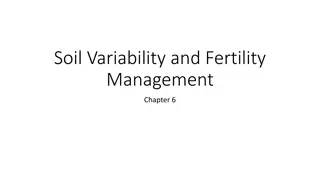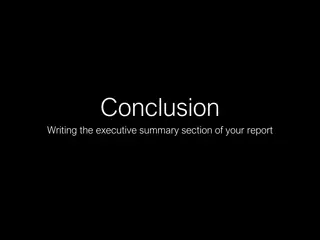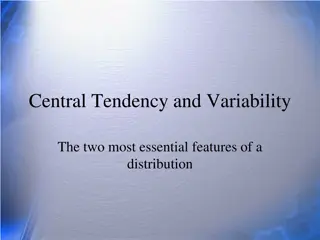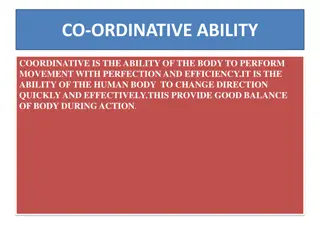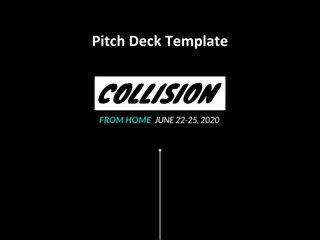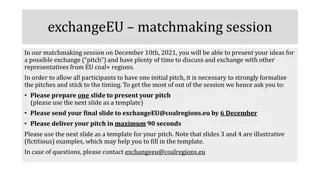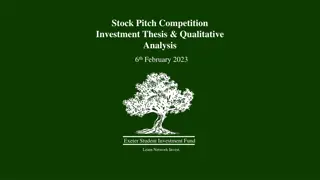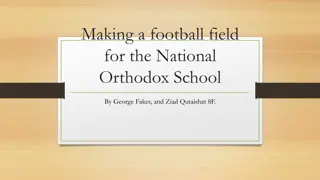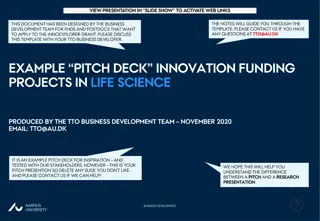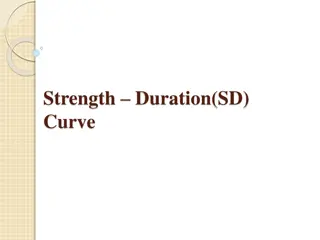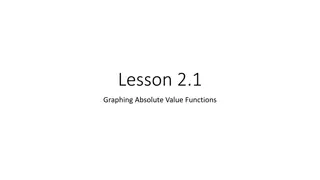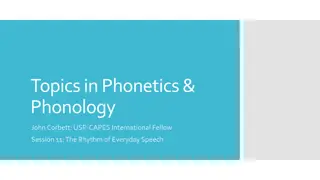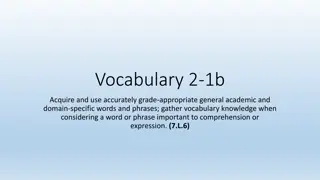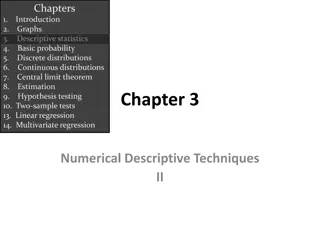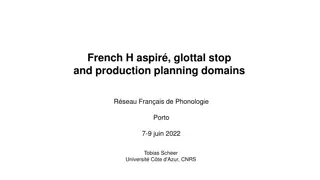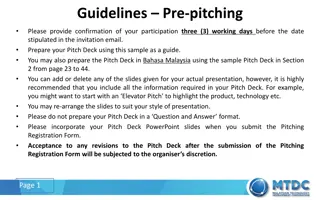Variability in Training Duration for Acquiring Absolute Pitch Ability
Sakakibara's study on acquiring absolute pitch ability revealed significant variability in the time taken by participants to pass pitch identification tests. Genetic predisposition may play a role, as differences were observed independent of factors like age, gender, and music experience. The study highlights the complex nature of individual differences in skill acquisition. Data from the study's histogram and detailed analysis shed light on the challenges in training for absolute pitch.
Download Presentation

Please find below an Image/Link to download the presentation.
The content on the website is provided AS IS for your information and personal use only. It may not be sold, licensed, or shared on other websites without obtaining consent from the author. Download presentation by click this link. If you encounter any issues during the download, it is possible that the publisher has removed the file from their server.
E N D
Presentation Transcript
Notes on Hambrick, Ulln, and Mosings Scientific American review of Peak: Secrets from the New Science of Expertise, by Anders Ericsson & Robert Pool
Histogram showing years to pass pitch identification test for trainees in Sakakibaras (2014) study Minimum = 2.2 y Maximum = 8.1 y Mean = 4.5 y Median = 3.6 y N = 22 There was a large amount of variability in how long it took the children (N = 22 finished study) to pass the pitch identification criterion test. Sakakibara (2014) notes: However, the possibility of a genetic predisposition in AP cannot be denied. In this study, 22 participants showed individual differences in the lengths of the periods of required training, the transitions of the number of chords and the percentages of various types of errors, although they were trained by an identical method. These differences cannot be explained by the fact that participants had different trainers. Nor do the observed differences appear to correlate with age, gender, and previous music experience of participants; thus potential causes of such differences remain unclear. Although it is overly simplistic to attribute these differences to genetic predisposition, genetic factors cannot be entirely eliminated as one source of individual differences. (pp. 101-102, emphasis added) Data from Table 2, Sakakibara, A. (2014). A longitudinal study of the process of acquiring absolute pitch: A practical report of training with the chord identification method . Psychology of Music, 42, 86-111. For data, go to: http://www.scienceofexpertise.com/resources
1) Charness, Tuffiash, Krampe, Reingold, & Vasyukova (2005) 2) de Bruin, Rikers, & Schmidt (2007) 3) Duckworth, Kirby, Tsukayama, Berstein, & Ericsson (2011) 4) Duffy, Baluch, & Ericsson (2004) 5) Ericsson, Krampe, & Tesch-R mer (1993) 6) Harris (2008) (dissertation supervised by Ericsson) 7) Helsen, Strakes, & Hodges (1998) 8) Hodges & Starkes (1996) 9) Hodges, Kerr, Starkes, Weir, & Nananidou (2004) 10) Hutchinson, Sachs-Ericsson, & Ericsson (2013) 11) Krampe & Ericsson (1993) 12) Sloboda et al. (1996) 13) Sonnentag & Kleine (2001) 14) Starkes et al. (1996) 15) Tuffiash, Roring, & Ericsson (2007) 16) Ward, Hodges, Williams, & Starkes (2004) 17) Young (1998); Young et al. (2008) (cited in Starkes et al.) 18) Law, C t , & Ericsson (2007)* Commenting on a meta-analysis by Macnamara, Hambrick, and Oswald (2014, Psychological Science), Ericsson and Pool state in Peakthat [t]he major problem with this meta-analysis was that few of the studies the researchers examined were actually looking at the effects of the type of practice on performance that we had referred to as deliberate practice (italics added). This is a misrepresentation of this research; as shown at right, the meta-analysis included numerous studies that looked at effects of the type of practice on performance that Ericsson and colleagues had referred to as deliberate practice (see direct quotations on later slides). Studies included in Macnamara et al. s (2014) meta-analysis that Ericsson and colleagues have used to argue for the importance of deliberate practice (also one dissertation supervised by Ericsson). *Law, C t , & Ericsson (2007) met the inclusion criteria, but was excluded from the meta-analysis because the effect size exceeded r = 1.0. Several of these articles included multiple studies, so the number of studies included in the meta- analysis that Ericsson has used to support deliberate practice view is even greater than 17 (about 1/4 of all studies in meta-analysis).
1) Charness, Tuffiash, Krampe, Reingold, & Vasyukova (2005) 2) de Bruin, Rikers, & Schmidt (2007) 3) Duckworth, Kirby, Tsukayama, Berstein, & Ericsson (2011) 4) Duffy, Baluch, & Ericsson (2004) 5) Ericsson, Krampe, & Tesch-R mer (1993) - Study 1 6) Harris (2008) (dissertation supervised by Ericsson) 7) Helsen, Strakes, & Hodges (1998) 8) Hodges & Starkes (1996) 9) Hodges, Kerr, Starkes, Weir, & Nananidou (2004) 10) Hutchinson, Sachs-Ericsson, & Ericsson (2013) 11) Krampe & Ericsson (1993) 12) Sloboda et al. (1996) 13) Sonnentag & Kleine (2001) 14) Starkes et al. (1996) 15) Tuffiash, Roring, & Ericsson (2007) 16) Ward, Hodges, Williams, & Starkes (2004) 17) Young (1998); Young et al. (2008) (cited in Starkes et al.) Ericsson and Pool also refer to Ericsson s (2014) unpublished critique of Macnamara, Hambrick, and Oswald s (2014) meta-analysis in which Ericsson argues that only one study (Ericsson et al., 1993, Study 2) meets his criteria for accurately estimating the relationship between deliberate practice and performance. However, as shown at right, Ericsson (2014) rejects numerous studies that he and his colleagues used to argue for the importance of deliberate practice (again, see direct quotations on later slides). Most perplexing, Ericsson rejects several of his own studies that he has used to argue for the importance of deliberate practice. As we have noted, using studies to argue for a theory, and then later rejecting the same studies as insufficient for evaluating that theory, seems like a major problem from a falsifiability perspective. Ericsson s unpublished critique can be found here: Studies included in Macnamara et al. s (2014) meta-analysis that Ericsson and colleagues have used to argue for the importance of deliberate practice (plus one dissertation supervised by Ericsson), but which Ericsson (2014) later rejected. Note that among the rejected studies are several of Ericsson and colleagues own studies (in red). See direct quotations on following slides https://psy.fsu.edu/faculty/ericsson/ericsson. hp.html
(1) Charness, Tuffiash, Krampe, Reingold, & Vasyukova (2005) The paper by Charness, Tuffiash, Krampe, Reingold, and Vasyukova (this issue) extends an earlier classic chapter by Charness, Krampe, and Mayr (1996) and examines retrospective estimates by a large sample of chess players about their training during the development of their skill and expertise. This paper reports the most compelling and detailed evidence for how designed training (deliberate practice) is the crucial factor in developing expert chess performance. - Ericsson (2005, p. 237), Applied Cognitive Psychology (2) de Bruin, Rikers, & Schmidt (2007) In a recent article, de Bruin et al. directly evaluated this hypothesis by collecting information on the amount of deliberate practice in a group of young elite chess players. Most importantly, this study showed that the amount of deliberate practice was related to the development of performance for all players. They found that a reduction in weekly deliberate practice led to a decrease in performance and eventually to the dropping out of this elite group. - Ericsson & Towne (2010, p. 410), Wiley Interdisciplinary Reviews: Cognitive Science *Ericsson & Towne cite de Bruin et al. (2008), but this is based on the same sample (N = 81) as de Bruin et al. (2007).
(3) Duckworth, Kirby, Tsukayama, Berstein, & Ericsson (2011) Deliberate practice, operationally defined as studying and memorizing words while alone, better predicted performance in the National Spelling Bee than being quizzed by others or reading for pleasure. Rated as the most effortful and least enjoyable type of preparation activity, deliberate practice was increasingly favored over being quizzed as spellers accumulated competition experience. Deliberate practice mediated the prediction of final performance by the personality trait of grit, suggesting that perseverance and passion for long-term goals enable spellers to persist with practice activities that are less intrinsically rewarding but more effective than other types of preparation. - Duckworth, Kirby, Tsukayama, Berstein, & Ericsson (2011, p. 174), Social Psych. and Personality Science
(4) Duffy, Baluch, & Ericsson (2004) This finding supports one of the main tenets of Ericsson et al.'s (1993) theory whereby expertise is acquired through a vast number of hours spent engaging in activities purely designed to improve performance, i.e., deliberate practice. - Duffy, Baluch, & Ericsson (2004, pp. 242-243), International Journal of Sport Psychology Several researchers have reported a consistent association between the amount and quality of solitary activities meeting the criteria of deliberate practice and performance in different domains of expertise, such as chess (Gobet & Charness, 2006), darts (Duffy, Baluch, & Ericsson, 2004), music (Lehmann & Gruber, 2006), many types of sports (Ward, Hodges, Williams, & Starkes, 2004), and several other diverse domains (Ericsson, 2006b). - Ericsson & Williams (2007, p. 119), JEP: Applied Several researchers have reported a consistent association between the amount and quality of solitary activities meeting the criteria of deliberate practice and performance in different domains of expertise, such as chess (Gobet & Charness, 2006), darts (Duffy, Baluch, & Ericsson, 2004), music (Lehmann & Gruber, 2006 ), many types of sports (Ward, Hodges, Starkes, & Williams 2007; Williams, Ericsson, Ward, & Eccles, 2008), Scrabble (Tuffiash et al., 2007), and several other diverse domains (Ericsson, 2006a ). - Ericsson et al. (2009, p. 9), In Ericsson et al. (Eds.), Development of Professional Expertise
(5) Ericsson, Krampe, & Tesch-Rmer (1993) - Study 1 We assessed current and past levels of deliberate practice in three groups of elite, adult violinists whose current performance differed. First we identified the activities constituting deliberate practice. We then determined the duration and organization of deliberate practice and contrasted them for the three groups. - Ericsson, Krampe, & Tesch-R mer (1993, p. 373), Psychological Review Not specific to Study 1 or Study 2, presumably referring to both: Ericsson et al. (1993) showed that the reported duration of this form of effective deliberate practice was related to the level of attained music performance. - C t , Ericsson, & Law (2007), Journal of Applied Sport Psychology Recent studies have shown that the individual differences in the level of solo performance that musicians attain after extended preparation is related to the amount of deliberate practice accumulated since the start of instrumental training by experts (Ericsson, Krampe, & Tesch-Romer, 1993) and by music students (Sloboda, Davidson, Howe, & Moore, 1996). - Lehmann & Ericsson (1996, p. 1), Psychomusicology (6) Harris (2008) Dissertation supervised by Ericsson; measures referred to as deliberate practice throughout this dissertation.
(7) Helsen, Starkes, & Hodges (1998) Several studies and reviews have since found a consistent relation between performance and amount and quality of deliberate practice in chess (Charness et al., 1996), in sports (Helsen et al, 1998; Hodges & Starkes, 1996; Starkes et al., 1996) and in music (Krampe & Ericsson, 1996; Lehmann & Ericsson, 1996; Sloboda, 1996). - Ericsson (1998, p. 87), High Ability Studies [T]he amount of time spent in team-related deliberate practice activities correlates reliably with skill level in team sports (Helsen et al., 1998; Ward et al., 2004). - Ericsson (2006, p. 695), In Ericsson et al. (Eds.), The Cambridge Handbook of Expertise and Expert Performance Several studies and reviews have found a consistent association between the amount and the quality of solitary deliberate practice and performance in chess (Charness, Krampe, & Mayr, 1996), in music (Krampe & Ericsson, 1996; Lehmann & Ericsson, 1996; Sloboda, 1996), and in different types of sports (Ericsson, 2003a, 2003b; Helsen, Starkes, & Hodges, 1998; Starkes, Deakin, Allard, Hodges, & Hayes, 1996; Ward, Hodges, Williams, & Starkes, 2004). - Ericsson, Nandagopal, & Roring (2005, p. 295), Journal for the Education of the Gifted Research conducted in several domains such as music (Ericsson, 2006a; Ericsson et al., 1993; Sloboda, 1996), sports (Helsen, Starkes, & Hodges, 1998; Hodges, Kerr, Starkes, Weir, & Nananidou, 2004), and chess (Charness et al., 2005), suggests that the amount of accumulated deliberate practice is closely related to an individual s attained level of performance. - Keith & Ericsson (2007, p. 136), JEP: Applied
(8) Hodges & Starkes (1996) Several studies and reviews have since found a consistent relation between performance and amount and quality of deliberate practice in chess (Charness et al., 1996), in sports (Helsen et al, 1998; Hodges & Starkes, 1996;Starkes et al., 1996) and in music (Krampe & Ericsson, 1996; Lehmann & Ericsson, 1996; Sloboda, 1996). - Ericsson (1998, p. 87), High Ability Studies Ericsson et al.'s (1993) claim that experts, when compared to novices, do in fact engage in vast amounts of deliberate practice has now been tested in several sporting activities requiring motor skills (e.g. soccer and field hockey; Helsen, Starkes, & Hodges, 1998; karate; Hodge and Deakin 1998: wrestling: Hodges and Starkes, 1996: figure skating: Starkes, Deakin, Allard, Hodges, & Hayes, 1996 and on long distance Canadian runners, Young and Salmela, 2002). - Duffy, Baluch, & Ericsson (2004, pp. 233-234), International Journal of Sport Psychology (9) Hodges, Kerr, Starkes, Weir, & Nananidou (2004) Research conducted in several domains such as music (Ericsson, 2006a; Ericsson et al., 1993; Sloboda, 1996), sports (Helsen, Starkes, & Hodges, 1998; Hodges, Kerr, Starkes, Weir, & Nananidou, 2004), and chess (Charness et al., 2005), suggests that the amount of accumulated deliberate practiceis closely related to an individual s attained level of performance. - Keith & Ericsson (2007, p. 136), JEP: Applied
(10) Hutchinson, Sachs-Ericsson, & Ericsson (2013) Based on the expert-performance framework, we predict that the attainment of increasingly higher levels of performance will be associated with the number of hours of supervised dance practice (deliberate practice) from an early age and will be predictive of the adult level of performance and dance expertise. - Hutchinson et al. (2013, p. 7), High Ability Studies (11) Krampe & Ericsson (1993) Several studies and reviews have since found a consistent relation between performance and amount and quality of deliberate practice in chess (Charness et al., 1996), in sports (Helsen et al, 1998; Hodges & Starkes, 1996; Starkes et al., 1996) and in music (Krampe & Ericsson, 1996; Lehmann & Ericsson, 1996; Sloboda, 1996). - Ericsson (1998, p. 87), High Ability Studies Several studies and reviews have found a consistent association between the amount and the quality of solitary deliberate practice and performance in chess (Charness, Krampe, & Mayr, 1996), in music (Krampe & Ericsson, 1996; Lehmann & Ericsson, 1996; Sloboda, 1996), and in different types of sports (Ericsson, 2003a, 2003b; Helsen, Starkes, & Hodges, 1998; Starkes, Deakin, Allard, Hodges, & Hayes, 1996; Ward, Hodges, Williams, & Starkes, 2004). - Ericsson, Nandagopal, & Roring (2005, p. 295), Journal for the Education of the Gifted
(12) Sloboda (1996) (describes data reported in Sloboda, Davidson, Howe, & Moore, 1996) Several studies and reviews have since found a consistent relation between performance and amount and quality of deliberate practice in chess (Charness et al., 1996), in sports (Helsen et al, 1998; Hodges & Starkes, 1996; Starkes et al., 1996) and in music (Krampe & Ericsson, 1996; Lehmann & Ericsson, 1996; Sloboda, 1996). - Ericsson (1998, p. 87), High Ability Studies Research conducted in several domains such as music (Ericsson, 2006a; Ericsson et al., 1993; Sloboda, 1996), sports (Helsen, Starkes, & Hodges, 1998; Hodges, Kerr, Starkes, Weir, & Nananidou, 2004), and chess (Charness et al., 2005), suggests that the amount of accumulated deliberate practiceis closely related to an individual s attained level of performance. - Keith & Ericsson (2007, p. 136), JEP: Applied Several studies and reviews have found a consistent association between the amount and the quality of solitary deliberate practice and performance in chess (Charness, Krampe, & Mayr, 1996), in music (Krampe & Ericsson, 1996; Lehmann & Ericsson, 1996; Sloboda, 1996), and in different types of sports (Ericsson, 2003a, 2003b; Helsen, Starkes, & Hodges, 1998; Starkes, Deakin, Allard, Hodges, & Hayes, 1996; Ward, Hodges, Williams, & Starkes, 2004). - Ericsson, Nandagopal, & Roring (2005, p. 295), Journal for the Education of the Gifted Recent studies have shown that the individual differences in the level of solo performance that musicians attain after extended preparation is related to the amount of deliberate practice accumulated since the start of instrumental training by experts (Ericsson, Krampe, & Tesch-Romer, 1993) and by music students (Sloboda, Davidson, Howe, & Moore, 1996). - Lehmann & Ericsson (1996, p. 1), Psychomusicology
(13) Sonnentag & Kleine (2000) [i]n a study of insurance agents Sonnentag and Kleinc [sic] (2000) found that engagement in deliberate practice predicted higher performance ratings. - Ericsson (2006, p. 695), In Ericsson et al. (Eds.), The Cambridge Handbook of Expertise and Expert Performance (14) Starkes et al. (1996) Several studies and reviews have since found a consistent relation between performance and amount and quality of deliberate practice in chess (Charness et al., 1996), in sports (Helsen et al, 1998; Hodges & Starkes, 1996; Starkes et al., 1996) and in music (Krampe & Ericsson, 1996; Lehmann & Ericsson, 1996; Sloboda, 1996). - Ericsson (1998, p. 87), High Ability Studies Studies find that even in these domains, the level of attained performance is related to the accumulated amount of deliberate practice (Starkes, Deakin, Allard, Hodges, & Hayes, 1996). - Ericsson (2003, pp. 114-115) Several studies and reviews have found a consistent association between the amount and the quality of solitary deliberate practice and performance in chess (Charness, Krampe, & Mayr, 1996), in music (Krampe & Ericsson, 1996; Lehmann & Ericsson, 1996; Sloboda, 1996), and in different types of sports (Ericsson, 2003a, 2003b; Helsen, Starkes, & Hodges, 1998; Starkes, Deakin, Allard, Hodges, & Hayes, 1996; Ward, Hodges, Williams, & Starkes, 2004). - Ericsson, Nandagopal, & Roring (2005, p. 295), Journal for the Education of the Gifted
(15) Tuffiash, Roring, & Ericsson (2007) Several researchers have reported a consistent association between the amount and quality of solitary activities meeting the criteria of deliberate practice and performance in different domains of expertise, such as chess (Gobet & Charness, 2006), darts (Duffy, Baluch, & Ericsson, 2004), music (Lehmann & Gruber, 2006 ), many types of sports (Ward, Hodges, Starkes, & Williams 2007; Williams, Ericsson, Ward, & Eccles, 2008), Scrabble (Tuffiash et al., 2007), and several other diverse domains (Ericsson, 2006a ). - Ericsson et al. (2009, p. 9), In Ericsson et al. (Eds.), Development of Professional Expertise (16) Ward, Hodges, Starkes, & Williams (2007) Several researchers have reported a consistent association between the amount and quality of solitary activities meeting the criteria of deliberate practice and performance in different domains of expertise, such as chess (Gobet & Charness, 2006 ), darts (Duffy, Baluch, & Ericsson, 2004 ), music (Lehmann & Gruber, 2006 ), many types of sports (Ward, Hodges, Starkes, & Williams 2007; Williams, Ericsson, Ward, & Eccles, 2008), Scrabble (Tuffiash et al., 2007), and several other diverse domains (Ericsson, 2006a ). - Ericsson, Perez, et al. (2009), In Ericsson et al. (Eds.), Development of Professional Expertise
(17) Young (1998); Young et al. (2008) Starkes et al. (chapter 10) provide compelling evidence for the role of deliberate practice in attaining and maintaining the strength, endurance, and flexibility of older Master athletes who sustain an exceptional level of performance. - Ericsson (2003, p. 73), In Expert Performance in Sports *This is a reference to a chapter by Starkes, Weir, and Young in the edited book Expert Performance in Sports, and appears to be a report of the data from Young (1998), and ultimately published by Young, Medic, Weir, & Starkes (2008). Note: Ericsson and colleagues use Young and Salmela s(2002) to argue for importance of deliberate practice; the meta-analysis included Young (2008), which included the data reported in Young and Salmela. Ericsson et al.'s (1993) claim that experts, when compared to novices, do in fact engage in vast amounts of deliberate practice has now been tested in several sporting activities requiring motor skills (e.g. soccer and field hockey; Helsen, Starkes, & Hodges, 1998; karate; Hodge and Deakin 1998: wrestling: Hodges and Starkes, 1996: figure skating: Starkes, Deakin, Allard, Hodges, & Hayes, 1996 and on long distance Canadian runners, Young and Salmela, 2002). - Duffy, Baluch, & Ericsson (2004, p. 233-234), International Journal of Sport Psychology
Other studies included in Macnamara et al.s (2014) meta-analysis used a methodology for assessing deliberate practice that was modeled after the procedure that Ericsson and colleagues have used. Examples: Gobet & Campitelli (2007) Lehmann & Ericsson (1996) Meinz (2000) Meinz & Hambrick (2010) Kopiez & Lee (2008) Ruthsatz, Detterman, Griscom, & Cirullo (2008) - S1 Schultetus & Charness (1997) Seems safe to assume procedure was after Ericsson et al., as this work was carried out at FSU
Comments on Hutchinson, Sachs-Ericsson, & Ericsson (2013) ballet study Ericsson and Pool (2016) note, Though we were working with fairly crude measures both of the total hours of practice of the dancers abilities there was still a relatively strong relationship between the reported amount of time spent on practice and how high a dancer had risen in the world of ballet. The implication here is that the relationship (correlation) would necessarily be stronger with better measures. This isn t the case; the relationship could just as easily be weaker. And, in fact, there is evidence to support this speculation: In their meta-analysis of deliberate practice in sports, Macnamara, Hambrick, and Oswald (2014) found that the deliberate practice- performance relationship was weaker for studies that used an objective measure of performance than for those that used less objective measures; from the article: The method used to assess performance was also a statistically significant moderator, Q(3) = 14.41, p = .002. The percentage of variance in performance explained by deliberate practice was 26% for studies that used group membership (r = .51, p < .001), 14% for studies that used laboratory tasks (r = .37, p < .001), 9% for studies that used expert ratings (r = .30, p < .001), and 8% for studies that used standardized objective scoring measures (r = .28, p < .001). And weaker for studies that used log-based measures of deliberate practice than for those that used retrospective reports; from the article: The method used to assess deliberate practice was a statistically significant moderator, Q(2) = 16.19, p < .001. The percentage of variance in performance explained by deliberate practice was 20% for studies that used a retrospective interview (r = .45, p < .001), 12% for studies that used a retrospective questionnaire (r = .34, p < .001), and 5% for studies that used a log method (r = .22, p < .001).





